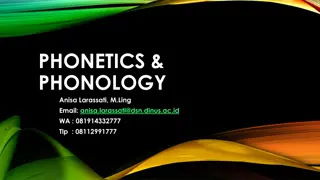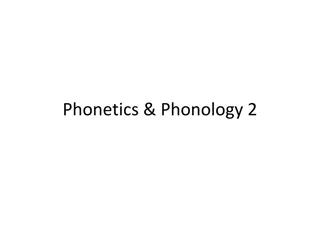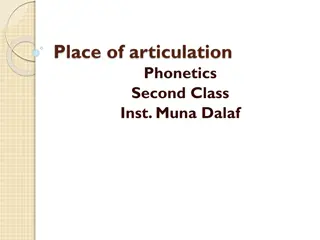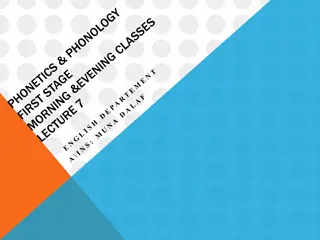Understanding Speech Sound Disorders in Children
Explore common communication disorders in children related to articulation and phonology, with insights on assessment and treatment methods. Learn about the challenges faced by individuals with speech sound disorders and the importance of early intervention.
3 views • 42 slides
Understanding Language and Linguistics
Language is a fundamental aspect of human communication, encompassing spoken and signed forms. Linguistics delves into syntax, semantics, morphology, phonology, and phonetics to analyze language structure and meaning. Phonetics explores how speech sounds are produced and perceived, shedding light on
9 views • 10 slides
AB 1111 and AB 928
Explore the significant impacts of Assembly Bills AB 1111 and AB 928 on daily work related to student transfer goals. Learn about the role of the Articulation Officer in supporting faculty and articulation efforts. Discover key concepts such as intersegmental transfer, general education, and baccala
2 views • 24 slides
ARTICULATION
Delve into the world of Computer-Supported Collaborative Work (CSCW) and the role of anthropology in understanding technology and social practice. Uncover key concepts like awareness, articulation work, and appropriation in group collaboration. Discover how technologies are shaped by their environme
0 views • 20 slides
Exploring Metrical Phonology: A Brief Overview
Metrical phonology, a subtheory of generative phonology, focuses on categorizing stress and stress rules within rhythmic hierarchies. It differs from generative phonology by not treating stress as a segmental feature specific to vowels. Originating from Halle's linear analysis, metrical stress theor
1 views • 32 slides
Exploring Bantu Phonology and Linguistic Classification
Delve into the intriguing world of Bantu phonology and linguistic classification, covering the diverse sounds and phonological processes found in Bantu languages. Discover the rich heritage of over 500 Bantu languages in sub-Saharan Africa, classified into zones and classes, shedding light on the fa
0 views • 38 slides
Understanding English Consonant Sounds: A Detailed Guide
This guide delves into the English phonetics and linguistics classification of consonant sounds, emphasizing factors such as place of articulation and manner of articulation. It covers various types of consonant sounds, from bilabial and labio-dental to alveolar, post-alveolar, palatal, velar, and g
1 views • 11 slides
Understanding Phonetics and Phonology in Linguistics
Phonetics and phonology are two essential fields in linguistics that focus on speech sounds in language. Phonetics involves the objective analysis of speech sounds, while phonology explores how these sounds form patterns in specific languages. Pronunciation problems often arise due to habit interfer
1 views • 56 slides
Understanding Syllable Structure and Stress in Phonetics and Phonology
Explore the concepts of syllable structure and stress in phonetics and phonology through examples like analyzing the number of syllables, phonemes, and stress patterns in words. Dive into syllable boundaries, onsets, nuclei, and rhymes in words and phrases to deepen your understanding of English pho
0 views • 35 slides
SAQA's Role in Implementing the Articulation Policy in Higher Education
SAQA presented progress made in implementing the Articulation Policy to the Parliamentary Portfolio Committee on Higher Education & Training. The policy aims to create linkages within the South African post-school education system. SAQA's responsibilities include setting criteria for articulation, c
1 views • 33 slides
Understanding Articulation in Phonetics and Speech Production
Exploring the vocal tract, active and passive articulators, and the complexity of the tongue's role in speech production. Identifying primary places of articulation and the intricate coordination of speech organs in producing sounds. Discover the significance of the rest position and how different p
3 views • 22 slides
Exploring Phonetics and Phonology: A Focus on American English Sounds for Brazilian Learners
This session reviews key aspects of phonetics and phonology, specifically focusing on segmentals and suprasegmentals of English, with an emphasis on the pronunciation of American English sounds. The goal is to help Brazilian learners improve their pronunciation skills to sound more native-like. Topi
1 views • 18 slides
French Phonology Study: C+yod in French Représentation
Research conducted by Tobias Scheer on 2nd July 2021 at Université Côte d'Azur, CNRS, BCL examines the occurrence of C+yod in French phonology. The study identifies specific patterns where C+yod occurs, emphasizing morphological boundaries and differentiating between lexical origins of the yod. Fu
0 views • 35 slides
Speech and Language Developmental Milestones: A Bilingual/Multilingual Perspective
Speech and language developmental milestones are crucial for children, regardless of their home language. These milestones encompass receptive language, expressive language, pragmatics, and articulation and phonology. Understanding how a child hears and talks from birth to one year is essential, as
1 views • 23 slides
Exploring Clarinet Articulation: Techniques and Strategies
Delve into the nuances of clarinet articulation with the University of North Texas faculty as they discuss the importance of slurring, tonguing, and airflow. Learn about effective breathing techniques, tongue positioning, and the role of air in creating a strong sound. Discover valuable resources fo
0 views • 23 slides
Exploring the World of Phonetics and Phonology
Delve into the fascinating realms of phonetics and phonology, where the science of human speech sounds is decoded. From the production to perception of sounds, this field encompasses articulatory phonetics, auditory phonetics, and acoustics phonetics. Discover how speech sounds are intricately forme
0 views • 25 slides
Understanding Phonetics and Phonology: Key Concepts and Differences
Phonology investigates sound distribution and interaction in language, providing an inventory of sounds and their interactions. Phonotactic constraints outline permissible sound sequences within a language, while phonemes and allophones distinguish between abstract and physical sound entities. Ident
0 views • 21 slides
Understanding Phonology Concepts in Language Learning
Phonology is the study of sounds in language and how they are produced. This content explores the production of sounds, types of sounds like plosives and fricatives, common phonological errors, and the "fis" phenomenon. It also discusses term deletion, exemplified by omission, substitution, addition
0 views • 13 slides
Statewide Articulation Agreement between MCCB and IHL
This statewide articulation agreement between the Mississippi Community College Board (MCCB) and the Institutions of Higher Learning (IHL) ensures smooth transfer of credits between community colleges and public universities in Mississippi. It outlines the courses accepted for transfer, is reviewed
0 views • 18 slides
Greek Phonology Exercises and Resources Overview
Explore Greek phonology exercises, resources like Wikipedia and Howe Library online, and key PIE sound transformations in Greek. Consult resources for laryngeal theory, Ancient Greek phonology, and Proto-Greek language.
0 views • 19 slides
Understanding Substance-Free Phonology and Its Implications
Substance-free phonology, as discussed by Tobias Scheer, explores the distinction between phonologically meaningful and meaningless items, highlighting their production and phonetic correlates. The article emphasizes the non-arbitrary nature of meaningful items and the arbitrary interchangeability o
0 views • 30 slides
The Three Modules of Phonology and Multiple-Module Spell-Out Systems
Phonology is structured into three modules - Sonority, Laryngeal, and Place - each with its own vocabulary and skeleton for computation. These modules interact in multiple-module spell-out systems to map linguistic structures onto phonetic realizations. Sonority, involving the audibility of linguist
0 views • 67 slides
Exploration of Substance-Free Phonology and Phonological Theory
This text delves into the concept of substance-free phonology, discussing the arbitrariness of phonological items, the distinction between phonologically meaningful and meaningless items, and the relationship between phonology and phonetics. It also explores the role of sonority in phonological theo
0 views • 11 slides
Linguistics: Exploring Grammar and Phonetics
Delve into the fascinating world of linguistics through an exploration of descriptive and prescriptive grammar rules, phonetics, phonology, morphology, syntax, semantics, and articulation features. Discover the intricate aspects of language structure and sound production in this comprehensive study
0 views • 69 slides
Overview of Second Class Instinctive Place of Articulation in Phonetics
Place of articulation in phonetics refers to the location where speech sounds are obstructed. There are 8 types of place of articulation, including bilabial, labio-dental, dentals, alveolar, palato-alveolar, palatal, velar, and glottis. Each type is characterized by the specific articulatory positio
0 views • 10 slides
Articulation and Transferability in Curriculum Development
Explore the world of articulation and transferability in curriculum development in this informative content. Learn about the differences between CCC articulation, CSU GE, IGETC, C-ID/ADT, and more. Discover the types of articulation and external approving bodies, along with best practices for approv
0 views • 8 slides
Integrating Disaster Risk Reduction into ICH Inventorying for UNESCO
Learn how to apply a community-based approach to inventorying and safeguarding intangible cultural heritage within the context of disasters. This presentation offers frameworks, tools, and exercises to integrate disaster awareness into ICH inventorying and safeguarding practices, emphasizing the imp
0 views • 15 slides
Sounds of Second Class Phonetic Manner of Articulation
Fricative sounds, produced by narrowing the air passage, create hissing sounds like /f/, /v/, /s/, /z/, and more. Affricates start as stops and end as fricatives, like in "chin" and "chest." Explore examples of sounds and articulation processes in English phonetics.
0 views • 6 slides
Understanding Music: Elements and Characteristics Explained
Explore the diverse elements that make up music, from melody and articulation to dynamics, time/tempo, structure, harmony, and instruments. Learn about the nuances of each aspect, including melody registers, articulation techniques, dynamic variations, tempo changes, structural formats, harmonic pri
0 views • 10 slides
Understanding English Phonetics and Phonology: An Introduction
The study of English phonetics and phonology is essential for understanding the physical characteristics of human speech sounds and their distribution in language systems. Phonetics focuses on the sounds themselves, while phonology delves into their classification and patterns within a language. Key
0 views • 8 slides
Understanding Phonemes and Phonology in English
Exploring the concept of phonemes and phonology in English phonetics, this text discusses how sounds are produced, segmented, and categorized. It delves into the abstract string of sound units known as phonemes, different realizations of the same phoneme called allophones, and the use of symbols and
0 views • 7 slides
Invitation for Study of Enets Prosody: Phonology and Intonation Insights
Explore Enets phonology and intonation with Olesya Khanina from the Institute of Linguistics, Russian Academy of Sciences. Discover the unique set of phonemes, patterns of variation, and stress patterns at the word level. Uncover interesting questions about Enets prosody through digital corpora anal
0 views • 21 slides
Understanding Phonology: The Study of Speech Sounds in Language
Phonology is a branch of linguistics that focuses on the organization and usage of speech sounds in natural languages, with phonemes being the smallest units of sound that carry meaning. This field explores the sound structure of languages, highlighting the variety of phonemes present across differe
0 views • 19 slides
Minimalist Approach to Syntax and Phonology in Linguistics
The discussion delves into the relationship between syntax and phonology in linguistics, emphasizing the minimalist approach that aims to create a clean syntax while considering phonology as an ancillary element. It explores the idea that syntax is central to grammar, while phonology is considered '
0 views • 40 slides
Introduction to Theoretical Phonology: Understanding Phonemes and Speech Sounds
The lecture explores the fundamental concepts of phonology, focusing on phonemes, speech sounds, phonological theories, and their historical background. It delves into the functions of phonemes in forming language units, distinguishing words, and their connection to meaning. Various theories and fun
0 views • 43 slides
Understanding Glottalisation of /t/ in English Phonology
Exploring the phonological process of glottalisation affecting the /t/ sound in English, focusing on intervocalic environments and beyond. The case study delves into word-final and word-medial positions, highlighting nuances in pronunciation and teaching points for syllable stress and articulation c
0 views • 13 slides
Overview of Fricative Sounds in English Pronunciation
This content discusses various fricative sounds in English pronunciation, focusing on the articulation of sounds like /s/ and /z/. It covers the positioning of the soft palate, tongue, teeth, and lips while producing these sounds, providing examples like "thin," "think," "free," and more. The conten
0 views • 11 slides
Understanding Elbow Joint Disorders in Veterinary Medicine
The elbow joint is a true diathrodial joint formed by the articulation of various structures. Disorders such as elbow luxation, un-united anconeal process, and fragmented coronoid process can lead to lameness and other clinical signs in animals. Causes include osteochondritis dissecans and trauma, w
0 views • 16 slides
Recent Advances in Old Chinese Phonology: Areal Perspectives and Syllabic Types
Explore the evolution of Old Chinese phonology through an areal perspective, focusing on the classification of syllabic types into Type A and Type B with further interpretations by linguistic scholars like Karlgren, Pulleyblank, and Norman.
0 views • 49 slides
Indiana Turnaround Committee Review - Policy Refinements and Proposal
The Indiana Turnaround Committee in October 2014 reviewed policy refinements focusing on academic success for students served. Key elements included enrollment stabilization, early intervention, and financial sustainability. The review emphasized clear articulation of building status, long-term scho
0 views • 13 slides







































